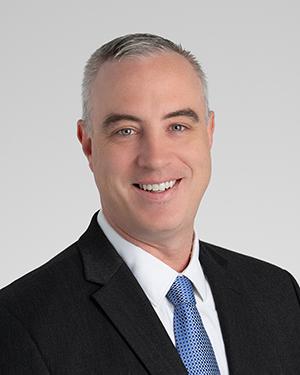Research News
08/23/2024
Assessing neighborhoods with high untreated hypertension provides basis for future community care
These neighborhoods, primarily on the region’s east side, will be the locations of Cleveland Clinic outreach programs to close healthcare gaps.

A Lerner College of Medicine medical student, Madeleine Blazel, has published essential data to address high rates of untreated high blood pressure (hypertension) in Northeast Ohio communities.
Cleveland Clinic is developing community intervention and outreach programs targeted towards the neighborhoods identified in Blazel’s research, published in JAMA Network Open. Blood pressure control has decreased on a national level since the COVID-19 pandemic, leaving many Americans to grapple with a preventable, but still dangerous condition.
“Untreated hypertension is a national problem, but local solutions can help close healthcare disparities.” says Elizabeth Pfoh, PhD, MPH, a health services researcher in Cleveland Clinic’s Center for Value-Based Care Research. “This study helps us understand where we need to focus our efforts to provide equitable care to everyone.”
As a CCLCM student, Blazel must complete a research year. She chose to work in Cleveland Clinic’s Center for Population Health Research (CPHR), which examines the complex interplay between socioeconomic factors like race, income and location in public health. Blazel worked alongside her Cleveland Clinic mentors Jarrod Dalton, PhD, Director of the CPHR; Dr. Pfoh and Bob (Robert) Jones Jr, MD; as well as collaborators from MetroHealth’s Population Health and Equity Research Institute (PHERI) including Adam Perzynski, PhD, also of the Case Western Reserve University Center for Health Care Research and Policy.
Blazel identified neighborhoods with high levels of untreated hypertension using Cleveland Clinic and MetroHealth de-identified electronic health records. To provide more insight, she integrated factors including race, geographic location and neighborhood disadvantage level. Blazel’s results demonstrate the benefits that come from collaboration between different healthcare institutions, Dr. Perzynski says.
“Cleveland Clinic and MetroHealth both have detailed understandings of our own patients. Only by combining our knowledge can we get a complete understanding of our community as a whole,” he explains. “Using what we know about our people to improve the health of our region is an area where we're deeply committed to collaborating.”
The combined patient data revealed that neighborhoods with the highest rates of untreated hypertension were characterized by a combination of low economic resources (such as income and housing costs) and majority Black populations. However, the link between neighborhood resource availability and untreated hypertension rate was observed among other racial and ethnic groups, underscoring the fact that these healthcare disparities are caused by a combination of many factors.
“Decades of housing and economic policy have led to an association between the racial and ethnic composition of neighborhoods and neighborhood resource availability in many areas in the United States, including Cleveland;” says Dr. Dalton. “Our data reinforce that the location someone lives in plays a huge role in mid-life health disparities, particularly hypertension risk."
In conducting their study, the team used Area Deprivation Index (ADI) scores, which uses factors like average income to neighborhood disadvantage. However, Blazel and her mentors all emphasize that despite these shared features, the neighborhoods cannot be treated as one entity.
“My goal with this project was to help my community in a meaningful, real way,” Blazel says. “We didn’t generate this map with a goal to identify specific issues or label problem locations. We did it to identify the areas where we can generate tangible solutions.”
Using data to ask the right questions, in the right places
High blood pressure is one of the easier conditions to prevent and treat with the proper resources, Dr. Pfoh says. With the correct diagnosis and treatment, individuals living in affected neighborhoods should go on to live healthy lives. Some existing community interventions for hypertension include introducing mobile screening units and increasing access to fresh food.
Drs. Pfoh and Perzynski both say that historical disinvestment from some neighborhoods has resulted in many factors that contribute to our blood pressure including food insecurity, high crime rates and outdated infrastructure. Healthcare interventions addressing these different factors is the key to targeting untreated high blood pressure at its root, they say. But what one community needs isn’t a surefire strategy for success in another, Blazel says. Even something as simple as better sidewalks or better access to a bus stop can influence a neighborhood’s overall heart health.
Even something as simple as better sidewalks or better access to a bus stop can influence a neighborhood’s overall heart health. But what one community needs isn’t a surefire strategy for success in another.
With this in mind, Blazel shared her findings with Cleveland Clinic’s Value Operations Group, which works directly with neighborhoods across Northeast Ohio to create healthier communities through intervention, education and outreach. Dr. Jones, who serves as Senior Director for the group’s Population Health Management team, is using the map as a starting point to develop blood pressure interventions tailored to each identified community.
Dr. Jones’s first step of action is to understand what drives the healthcare disparities in each neighborhood. These factors can include lack of access to healthcare or health education or more specific needs, like food insecurity. Dr. Jones is collaborating with an Ambulatory Care Management team of community care coordinators, social workers, community liaisons and Center for Community Health workers to identify opportunities for Cleveland Clinic to deliver solutions.
“Whether it’s asking patients from these areas as they come into the clinic or going directly into local gathering spots like churches or barbershops, we are gathering information so we can work directly with the community to develop a better care model that suits their needs,” Dr. Jones says.
Featured Experts
News Category
Related News
Research areas
Want To Support Ground-Breaking Research at Cleveland Clinic?
Discover how you can help Cleveland Clinic save lives and continue to lead the transformation of healthcare.
Give to Cleveland Clinic